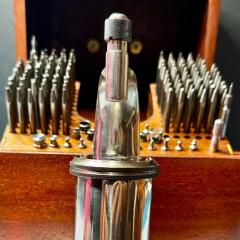Strange markings on Omega dial-back
-
Recently Browsing
- No registered users viewing this page.
-
Topics
-
Posts
-
Someone just made me aware that no images are showing in my post ( ). Could someone with the proper permissions check this? I believe the images are ones I uploaded to the site, but they could also be ones I shared from my OneDrive, which had an issue some time ago.
-
By Pigskinfanboy · Posted
I would have jumped all over that set if it had come across my Ebay search results ! Very nice , well taken care of. I probably buy 10+ staking sets a month for my restoration hobby and think you found a very nice set, at a great price that should last you a lifetime. -
By nickelsilver · Posted
Here's another old tool that doesn't get used much, but has saved me many hours and headaches when it has been. This is a depthing tool, but quite special. The depth can be set (or measured) very precisely with the micrometer to the right, with a direct reading of the actual center distance between the wheel and pinion. It originally came with a set of the little plates in the slots to the right that take the pivots (first pic), most of mine are missing but they can be made when needed. The section that takes the right hand wheel can be adjusted in height. And it can be set on a profile projector if needed to check things. This one is marked Tripet, but most I have seen are marked Hauser. All of them were made by a small company in La Chaux de Fonds (can't think of the name now). -
This would be the case on a chronograph movement but the Ronda 515 doesn't have an AC contact. Here's an example of a Seiko movement with the AC Reset.
-
There seems to be a way to "short" the thing to what they call an AC Reset... Makes a bit of sense, only problem is that i have to firstly re-assemble the movement.
-






Recommended Posts
Join the conversation
You can post now and register later. If you have an account, sign in now to post with your account.
Note: Your post will require moderator approval before it will be visible.